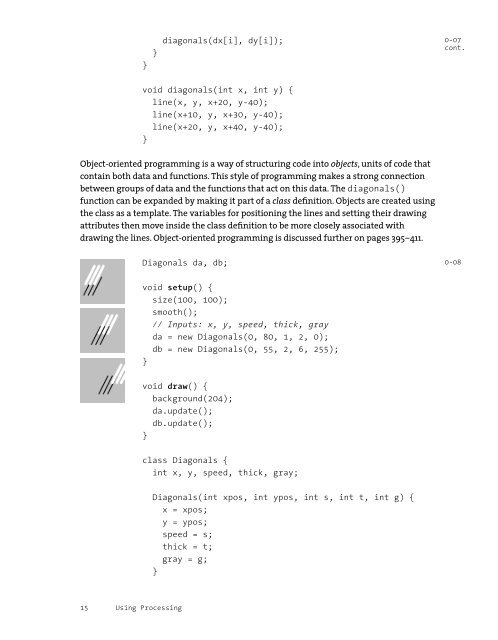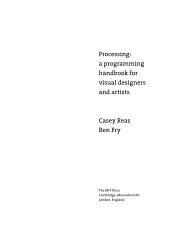Fractal.Invaders, Substrate (Interview with Jared Tarbell) - Processing
Fractal.Invaders, Substrate (Interview with Jared Tarbell) - Processing
Fractal.Invaders, Substrate (Interview with Jared Tarbell) - Processing
You also want an ePaper? Increase the reach of your titles
YUMPU automatically turns print PDFs into web optimized ePapers that Google loves.
15 Using <strong>Processing</strong><br />
}<br />
}<br />
diagonals(dx[i], dy[i]);<br />
void diagonals(int x, int y) {<br />
line(x, y, x+20, y-40);<br />
line(x+10, y, x+30, y-40);<br />
line(x+20, y, x+40, y-40);<br />
}<br />
Object-oriented programming is a way of structuring code into objects, units of code that<br />
contain both data and functions. This style of programming makes a strong connection<br />
between groups of data and the functions that act on this data. The diagonals()<br />
function can be expanded by making it part of a class defi nition. Objects are created using<br />
the class as a template. The variables for positioning the lines and setting their drawing<br />
attributes then move inside the class defi nition to be more closely associated <strong>with</strong><br />
drawing the lines. Object-oriented programming is discussed further on pages 395–411.<br />
Diagonals da, db;<br />
void setup() {<br />
size(100, 100);<br />
smooth();<br />
// Inputs: x, y, speed, thick, gray<br />
da = new Diagonals(0, 80, 1, 2, 0);<br />
db = new Diagonals(0, 55, 2, 6, 255);<br />
}<br />
void draw() {<br />
background(204);<br />
da.update();<br />
db.update();<br />
}<br />
class Diagonals {<br />
int x, y, speed, thick, gray;<br />
Diagonals(int xpos, int ypos, int s, int t, int g) {<br />
x = xpos;<br />
y = ypos;<br />
speed = s;<br />
thick = t;<br />
gray = g;<br />
}<br />
0-07<br />
cont.<br />
0-08



